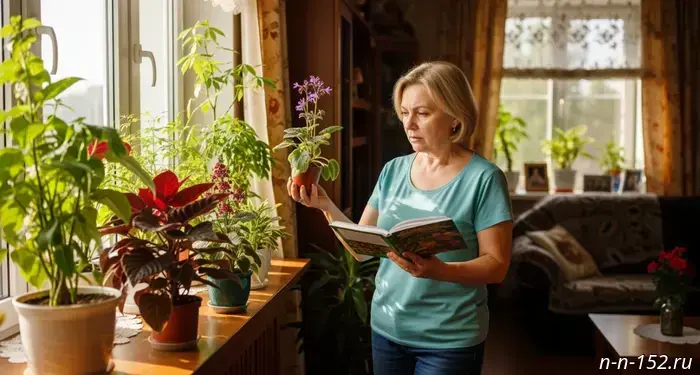
Killer Flowers: 10 Toxic Houseplants That Are Dangerous to Keep at Home
Photo AI progorodnn.ru
Dangerous Indoor Plants and Precautions
Decorating a home with indoor plants requires remembering that some of them can pose health risks to people and pets. Before bringing a new "green pet" into the house, it is important to study its potentially toxic properties.
Special caution should be exercised with the following plants:
Dieffenbachia: The sap of this plant contains calcium oxalate crystals, causing severe burning and swelling upon contact with skin or mucous membranes. In some cases, temporary loss of voice is possible, giving it the second name "Dumb Cane." Monstera: Also contains calcium oxalates. The plant's sap irritates the skin, and when it contacts the mouth, it causes swelling of the tongue and larynx, hindering breathing. This plant is particularly dangerous for pets, which may chew on the leaves. Azalea: Contains glycosides. Ingesting the leaves or flowers of an azalea can lead to poisoning, accompanied by nausea, vomiting, diarrhea, and excessive salivation. Severe cases may cause seizures. Children are more sensitive to its poison. Anthurium: This plant provokes the production of histamine, which can cause allergic reactions: itching, skin redness, swelling, and even anaphylactic shock in allergy-prone individuals. Begonia: Contains oxalate salts. Contact with the sap of begonia can cause burns and skin irritation, mucous membrane swelling, and digestive disturbances. The tubers are especially toxic, so gloves are recommended during transplanting. Ficus Benjamina: The sap of the ficus, containing latex and alkaloids, causes dermatitis, allergies, and skin irritation. Additionally, particles of latex released into the air pose a danger to allergy sufferers. Euphorbia: The milky sap of poinsettia is toxic and causes irritation and itching upon contact with skin. Ingestion can lead to nausea, vomiting, and diarrhea. Hippeastrum: Contains toxic substances, especially in the bulbs. The alkaloid lycorine present in hippeastrum can cause vomiting, diarrhea, and kidney failure in cats and dogs. Oleander: This plant is extremely dangerous. All parts contain cardiac glycosides that disrupt heart rhythm and nervous system functions. Even a small amount of oleander can be fatal, especially for children and animals. It is not recommended to keep it in the bedroom. Trichocereus cactus: Some species contain the alkaloid mescaline, which has hallucinogenic properties. While accidental human poisoning is unlikely, ingestion can cause seizures and paralysis. To ensure safety, it is crucial to keep toxic plants out of reach of children and pets, as their bodies are more sensitive to toxins. According to the American Society for the Prevention of Cruelty to Animals (ASPCA), every second case of plant poisoning in their veterinary centers involves animals exposed to indoor plants. Do not leave plant parts where children or pets can reach them. Regularly prune withered leaves and flowers to prevent accidental ingestion. Use gloves when repotting plants. If poisoning is suspected, seek medical or veterinary help immediately.
Interesting fact: Among plants often called "air cleaners," Sansevieria, or "Mother-in-law's tongue," actively absorbs carbon dioxide and releases oxygen at night, making it an ideal plant for the bedroom, and it is practically harmless. Botany and toxicology experts emphasize that even the most beautiful plants can be dangerous. For example, Dr. Elena Petrova, senior researcher at the Institute of Botany, notes: "Conscious plant choices and simple precautions are key to safe coexistence with indoor plants." Knowing these features will help create a safe and comfortable environment in your home, minimizing risks. Remember that, according to a study by the University of Georgia, over 60% of all plant poisoning cases in children under 6 are related to plants widely used in home interiors.

Другие Новости Нижнего (Н-Н-152)
 Preferential loans doubled support for Nizhny Novgorod's industry
News of Nizhny Novgorod
Preferential loans doubled support for Nizhny Novgorod's industry
News of Nizhny Novgorod
 The budget of the Nizhny Novgorod region has been increased by 600 million due to federal receipts.
Budget revenues increased to 365.3 billion rubles.
On July 31, the deputies of the Legislative Assembly of the Nizhny Novgorod Region approved amendments to the regional budget for 2025 and the planned period of 2026–2027. 31.07.2025. Newsroom24.Ru. Nizhny Novgorod Region. Nizhny Novgorod.
The budget of the Nizhny Novgorod region has been increased by 600 million due to federal receipts.
Budget revenues increased to 365.3 billion rubles.
On July 31, the deputies of the Legislative Assembly of the Nizhny Novgorod Region approved amendments to the regional budget for 2025 and the planned period of 2026–2027. 31.07.2025. Newsroom24.Ru. Nizhny Novgorod Region. Nizhny Novgorod.
 The deaths of two teenagers in the Nizhny Novgorod water bodies resulted in criminal cases.
News of Nizhny Novgorod
The deaths of two teenagers in the Nizhny Novgorod water bodies resulted in criminal cases.
News of Nizhny Novgorod
 A bucket of cold water for the dressed: Yuri Stankevič on fines for begging
News of Nizhny Novgorod
A bucket of cold water for the dressed: Yuri Stankevič on fines for begging
News of Nizhny Novgorod
 Railway workers will raise funds to help children with cancer.
News of Nizhny Novgorod
Railway workers will raise funds to help children with cancer.
News of Nizhny Novgorod
-demands-that-the-Balakhna-utility-company-fully-eliminate-environmental-violations-and-cease-discharging-insufficiently-treated-wastewater-into-the-Volga.jpg) The Federal Service for Supervision of Natural Resources (Rosprirodnadzor) demands that the Balakhna utility company fully eliminate environmental violations and cease discharging insufficiently treated wastewater into the Volga.
The court once again upheld the position of the Interregional Directorate of Rosprirodnadzor for the Nizhny Novgorod Region and the Republic of Mordovia, July 31, 2025. Rosprirodnadzor. Nizhny Novgorod Region. Nizhny Novgorod.
The Federal Service for Supervision of Natural Resources (Rosprirodnadzor) demands that the Balakhna utility company fully eliminate environmental violations and cease discharging insufficiently treated wastewater into the Volga.
The court once again upheld the position of the Interregional Directorate of Rosprirodnadzor for the Nizhny Novgorod Region and the Republic of Mordovia, July 31, 2025. Rosprirodnadzor. Nizhny Novgorod Region. Nizhny Novgorod.
Killer Flowers: 10 Toxic Houseplants That Are Dangerous to Keep at Home
Photo AI progorodnn.ru Dangerous Houseplants and Precautions When decorating your home with houseplants, it is important to remember that some of them can pose health risks to humans and pets. 01.08.2025. ProGorodNN.Ru. Nizhny Novgorod Region. Nizhny Novgorod.
